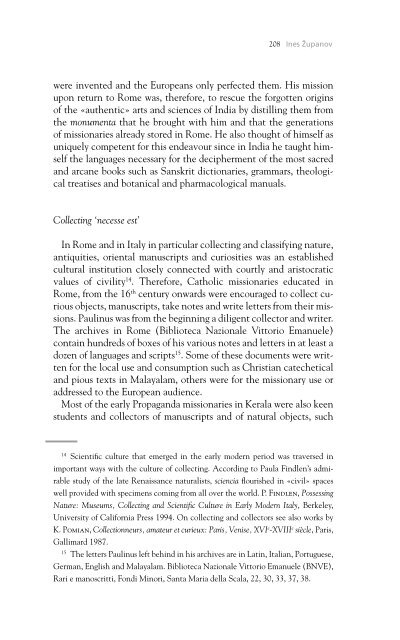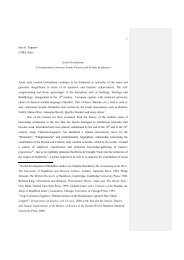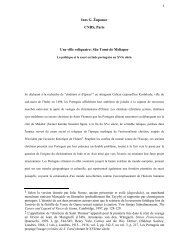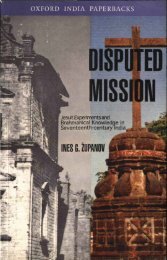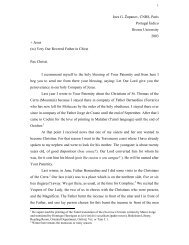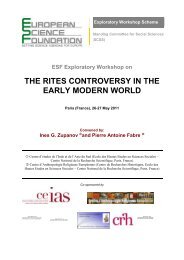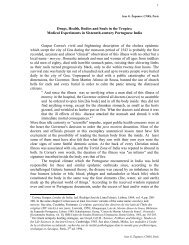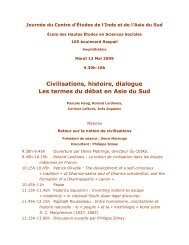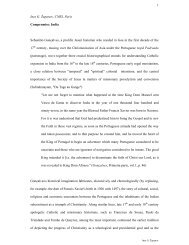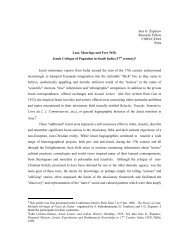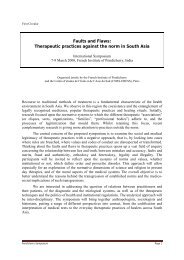Professional Missionary and Orientalist Curator ... - Ines G. Županov
Professional Missionary and Orientalist Curator ... - Ines G. Županov
Professional Missionary and Orientalist Curator ... - Ines G. Županov
Create successful ePaper yourself
Turn your PDF publications into a flip-book with our unique Google optimized e-Paper software.
208 <strong>Ines</strong> <strong>Županov</strong><br />
were invented <strong>and</strong> the Europeans only perfected them. His mission<br />
upon return to Rome was, therefore, to rescue the forgotten origins<br />
of the «authentic» arts <strong>and</strong> sciences of India by distilling them from<br />
the monumenta that he brought with him <strong>and</strong> that the generations<br />
of missionaries already stored in Rome. He also thought of himself as<br />
uniquely competent for this endeavour since in India he taught himself<br />
the languages necessary for the decipherment of the most sacred<br />
<strong>and</strong> arcane books such as Sanskrit dictionaries, grammars, theological<br />
treatises <strong>and</strong> botanical <strong>and</strong> pharmacological manuals.<br />
Collecting ‘necesse est’<br />
In Rome <strong>and</strong> in Italy in particular collecting <strong>and</strong> classifying nature,<br />
antiquities, oriental manuscripts <strong>and</strong> curiosities was an established<br />
cultural institution closely connected with courtly <strong>and</strong> aristocratic<br />
values of civility 14 . Therefore, Catholic missionaries educated in<br />
Rome, from the 16 th century onwards were encouraged to collect curious<br />
objects, manuscripts, take notes <strong>and</strong> write letters from their missions.<br />
Paulinus was from the beginning a diligent collector <strong>and</strong> writer.<br />
The archives in Rome (Biblioteca Nazionale Vittorio Emanuele)<br />
contain hundreds of boxes of his various notes <strong>and</strong> letters in at least a<br />
dozen of languages <strong>and</strong> scripts 15 . Some of these documents were written<br />
for the local use <strong>and</strong> consumption such as Christian catechetical<br />
<strong>and</strong> pious texts in Malayalam, others were for the missionary use or<br />
addressed to the European audience.<br />
Most of the early Propag<strong>and</strong>a missionaries in Kerala were also keen<br />
students <strong>and</strong> collectors of manuscripts <strong>and</strong> of natural objects, such<br />
14<br />
Scientific culture that emerged in the early modern period was traversed in<br />
important ways with the culture of collecting. According to Paula Findlen’s admirable<br />
study of the late Renaissance naturalists, sciencia flourished in «civil» spaces<br />
well provided with specimens coming from all over the world. P. Findlen, Possessing<br />
Nature: Museums, Collecting <strong>and</strong> Scientific Culture in Early Modern Italy, Berkeley,<br />
University of California Press 1994. On collecting <strong>and</strong> collectors see also works by<br />
K. Pomian, Collectionneurs, amateur et curieux: Paris, Venise, XVI e -XVIII e siècle, Paris,<br />
Gallimard 1987.<br />
15<br />
The letters Paulinus left behind in his archives are in Latin, Italian, Portuguese,<br />
German, English <strong>and</strong> Malayalam. Biblioteca Nazionale Vittorio Emanuele (BNVE),<br />
Rari e manoscritti, Fondi Minori, Santa Maria della Scala, 22, 30, 33, 37, 38.


